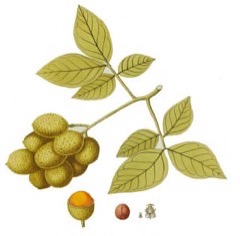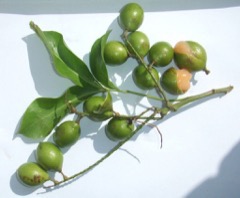 |
|
http://www.edibleplants.org |
 |
| wikimedia.org |
Translate this page:
Summary
Melicoccus bijugatus or commonly known as Mamoncillo is an evergreen and slow-growing fruit tree native to northern South America. It grows up to 25 m in height and up to 60 cm in trunk diameter. It has alternate, compound leaves comprised of four elliptic leaflets. The crown is round and dense. The think is smooth and light gray. The flowers are small and green. Aside from being planted as an ornamental tree, it is also popular for its edible fruits which are green drupes with a sweet or sour flavor. It can be consumed raw when ripe, or made into jams, pies, jellies, candies, etc. The seeds are large, usually roasted and used as cassava substitute. The wood of Mamoncillo is fairly hard and heavy, and ideal for cabinet work, construction, and interior works. Propagation is through seeds, air layering, or grafting.
Physical Characteristics

 Melicoccus bijugatus is an evergreen Tree growing to 18 m (59ft) by 18 m (59ft) at a slow rate.
Melicoccus bijugatus is an evergreen Tree growing to 18 m (59ft) by 18 m (59ft) at a slow rate.
See above for USDA hardiness. It is hardy to UK zone 10 and is frost tender. The flowers are pollinated by Bees.
It is noted for attracting wildlife.
Suitable for: light (sandy), medium (loamy) and heavy (clay) soils, prefers well-drained soil and can grow in nutritionally poor soil. Suitable pH: neutral and basic (mildly alkaline) soils and can grow in very alkaline and saline soils.
It can grow in semi-shade (light woodland) or no shade. It prefers dry or moist soil and can tolerate drought. The plant can tolerates strong winds but not maritime exposure.
UK Hardiness Map
US Hardiness Map
Synonyms
Melicoccus bijuga L. Melicoccus carpopodea Juss. Paullinia sphaerocarpa Rich. ex Juss.
Plant Habitats
Edible Uses
Edible Parts: Fruit Seed
Edible Uses: Drink
Fruit - raw or cooked. The fruit is juicy, aromatic and somewhat sweet with a pleasant, acid flavour. A sweet and gelatinous pulp with a grape-like flavour[200 ]. Usually eaten out of hand, they can also be cooked in pies, jams and jellies etc[301]. They make a cooling drink[301 ]. The fruit is up to 3cm in diameter, containing a single, occasionally two, large seed[200]. The large, starchy seeds are roasted and used as a substitute for cassava[200, 301, 317 , 335 ]. The elliptic seeds can be up to 28mm long[447 ].
References More on Edible Uses
Medicinal Uses
Plants For A Future can not take any responsibility for any adverse effects from the use of plants. Always seek advice from a professional before using a plant medicinally.
Antidiarrhoeal Antihydrotic Dysentery
A decoction of the bark is widely used by local people to treat dysentery[200 ]. An infusion of the leaves is used to decrease or retard perspiration[348 ].
References More on Medicinal Uses
The Bookshop: Edible Plant Books
Our Latest books on Perennial Plants For Food Forests and Permaculture Gardens in paperback or digital formats.

Edible Tropical Plants
Food Forest Plants for Hotter Conditions: 250+ Plants For Tropical Food Forests & Permaculture Gardens.
More

Edible Temperate Plants
Plants for Your Food Forest: 500 Plants for Temperate Food Forests & Permaculture Gardens.
More

More Books
PFAF have eight books available in paperback and digital formats. Browse the shop for more information.
Shop Now
Other Uses
Furniture Wood
Seaside and Shade tree. Street tree. Specimen. Xerophytic. Other Uses The heartwood is light brown to pale yellow-gray; the sapwood light brown. The wood is of medium weight, fairly hard but does not resist decay. It is sometimes used for cabinet work, construction and interior works[307 , 447 ].
Special Uses
Food Forest
References More on Other Uses
Cultivation details
A plant of the moist, lowland tropics, where it is found at elevations up to 600 metres. It grows best in areas where annual daytime temperatures are within the range 22 - 30°c, but can tolerate 13 - 34°c[418 ]. When dormant, the plant can survive temperatures down to about -3°c, but young growth can be severely damaged at -1°c[418 ]. It prefers a mean annual rainfall in the range 800 - 1,600mm, but tolerates 500 - 2,700mm[418 ]. Prefers a fertile, well-drained soil in a sunny position[307 ], though it can also succeed in poor soils[335 ]. Prefers a pH in the range 5.5 - 7, tolerating 5 - 8.7[418 ]. Established plants are very drought tolerant[307 , 335 ]. Plants can withstand the strongest salt-laden winds[307 ]. Seedling plants take 7 - 10 years to begin fruiting[307 , 335 ]. Cuttings can fruit in 4 - 5 years[335 ]. The flowers are pleasantly scented and attract bees[447 ]. There are some named varieties[301 ]. Trees are intolerant of pruning[307 ]. Some members of this species are hermaphrodite, whilst others can be dioecious[307 ]. Most forms are dioecious, in which case it is necessary to grow both male and female forms if fruit and seed are required[335 ]. Flowering Time: Late Winter/Early Spring Mid SSpring. Bloom Color: White/Near White. Spacing: 20-30 ft. (6-9 m).
References Carbon Farming Information and Carbon Sequestration Information
Temperature Converter
Type a value in the Celsius field to convert the value to Fahrenheit:
Fahrenheit:
The PFAF Bookshop
Plants For A Future have a number of books available in paperback and digital form. Book titles include Edible Plants, Edible Perennials, Edible Trees,Edible Shrubs, Woodland Gardening, and Temperate Food Forest Plants. Our new book is Food Forest Plants For Hotter Conditions (Tropical and Sub-Tropical).
Shop Now
Plant Propagation
Seed - seedlings often do not fruit as well as their parent[200 ]. Air layering. Greenwood cuttings. Grafting.
Other Names
If available other names are mentioned here
Mamoncillo, Spanish Lime, Guayo, Honeyberry, Limoncillo, Genipe, Ginep, Ginip, Grosella de miel, Guayo, Guenepa, Guinep, Honey-berry, Kanappy, Kenep, Kinep, Limoncillo, Mamon, Mamoncilho, Pitomba-das-guianas, Quenep, ackee, genip, guinep, honeyberry, mamoncillo, quenepa, spanish lime,
Native Range
SOUTHERN AMERICA: Venezuela, Brazil, Colombia,
Weed Potential
Right plant wrong place. We are currently updating this section.
Please note that a plant may be invasive in one area but may not in your area so it's worth checking.
Conservation Status
IUCN Red List of Threatened Plants Status : This taxon has not yet been assessed

Growth: S = slow M = medium F = fast. Soil: L = light (sandy) M = medium H = heavy (clay). pH: A = acid N = neutral B = basic (alkaline). Shade: F = full shade S = semi-shade N = no shade. Moisture: D = dry M = Moist We = wet Wa = water.
Now available:
Food Forest Plants for Mediterranean Conditions
350+ Perennial Plants For Mediterranean and Drier Food Forests and Permaculture Gardens.
[Paperback and eBook]
This is the third in Plants For A Future's series of plant guides for food forests tailored to
specific climate zones. Following volumes on temperate and tropical ecosystems, this book focuses
on species suited to Mediterranean conditions—regions with hot, dry summers and cool, wet winters,
often facing the added challenge of climate change.
Read More
Expert comment
Author
Jacq.
Botanical References
Links / References
For a list of references used on this page please go here
A special thanks to Ken Fern for some of the information used on this page.
Readers comment
| Add a comment |
|
If you have important information about this plant that may help other users please add a comment or link below. Only comments or links that are felt to be directly relevant to a plant will be included. If you think a comment/link or information contained on this page is inaccurate or misleading we would welcome your feedback at [email protected]. If you have questions about a plant please use the Forum on this website as we do not have the resources to answer questions ourselves.
* Please note: the comments by website users are not necessarily those held by PFAF and may give misleading or inaccurate information.
To leave a comment please Register or login here All comments need to be approved so will not appear immediately.
|
Subject : Melicoccus bijugatus
|
|
|
|